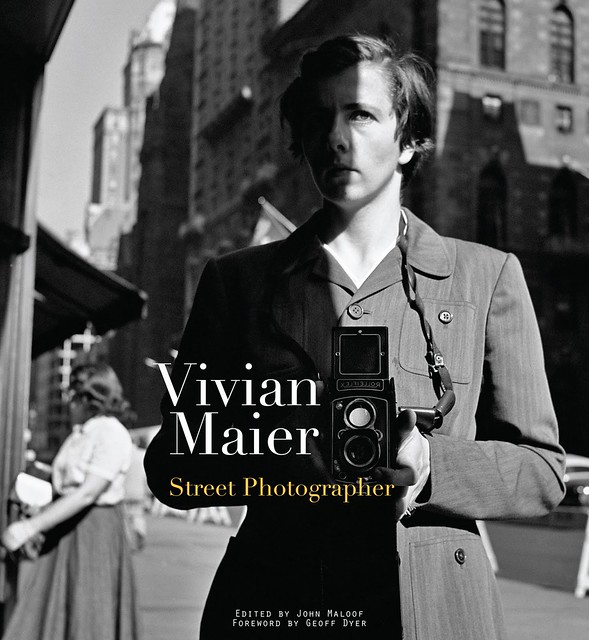
![]() BY MIKE WALSH In 1951, at age 25, a young woman named Vivian Maier moved from France to New York City, where she worked for some time in a sweat shop. Maier also had a camera, and she spent much of her free time walking around NYC working class neighborhoods taking photos of people, places, and buildings.
BY MIKE WALSH In 1951, at age 25, a young woman named Vivian Maier moved from France to New York City, where she worked for some time in a sweat shop. Maier also had a camera, and she spent much of her free time walking around NYC working class neighborhoods taking photos of people, places, and buildings.
She used a Rolleiflex camera, the type you look down into a two-inch lens to aim and focus. It used 120 mm film, a large format that, in the hands of someone like Maier, can capture incredible richness, detail, and depth of field.
In 1956, Vivian moved to Chicago where she worked for the next four decades as a nanny for numerous upper middle-class families. She continued with her photography in Chicago, taking photos obsessively. Lots of them. Tens of thousands.
Photos of wealthy women dressed in hats and furs on their way to social functions; dirty-faced children; roostering adolescents with flamboyant haircuts; a heavyset woman arguing with a cop; homes destroyed by a tornado; a salesman asleep in a car; the working class in action, and bums passed out on a sidewalk or the beach. Unusual buildings, street life, light, shadow, and clothing always drew her attention. 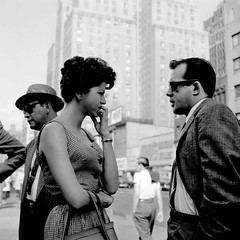 She seemed to identify most with immigrants and the dispossessed.
She seemed to identify most with immigrants and the dispossessed.
In most cases, the subjects were not aware they were being photographed. Some seemed surprised and scowled at her. Others posed for her. Some glare, some smile. She hardly ever took more than one photo of anything.
Maier had no formal training in photography and no network of peers. She worked by herself. And somehow she became a great artist, but she never told anyone about her photography. She simply didn’t not stop pursuing her obsession long enough to share the results.
She didn’t date. She didn’t marry. She didn’t seem to have friends. She wasn’t interested in that. She showed little interest in human contact but, instead, channeled it into her photography, which is in fact drenched in humanity.
Each time she moved to a different job and a different family, she had more boxes of negatives and prints. Some were filled with home movies and audio recordings she had made. At one employer’s house, she stored 200 boxes of materials. At some point she inherited money from relatives in France and took a trip around the world by herself, taking photos along the way.
She took many wonderfully inventive self-portraits as well, mostly reflections of her and her camera in mirrors, plate glass windows, ceiling-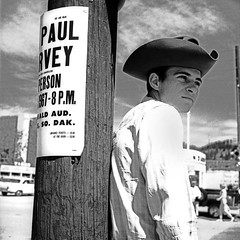 mounted store mirrors, and chrome hubcaps. What we see is a tall, thin, homely woman, usually in drab clothing, the type you’d expect to see on a nanny with little income. Maier has chin-length hair parted on one side, a weak chin, and a nose that angles up. Some self-portraits show only her shadow.
mounted store mirrors, and chrome hubcaps. What we see is a tall, thin, homely woman, usually in drab clothing, the type you’d expect to see on a nanny with little income. Maier has chin-length hair parted on one side, a weak chin, and a nose that angles up. Some self-portraits show only her shadow.
As she aged, Vivian’s financial situation got progressively worse, but she kept taking photos. She could afford to buy film but not to develop it, so she packed hundreds of rolls of undeveloped film in yet more boxes.
By 2000, Vivian was out of work and destitute. She was living on Social Security. Her negatives and other belongings were in storage, but she couldn’t pay the storage bill. By then the children she had cared for in the1950s were adults. When they found out about Vivian’s situation, they got her an apartment and paid her bills.
————————–
In 2007, a 26-year-old Chicago real estate agent named John Maloof was working on a history of his neighborhood. He heard about some old photos from an abandoned storage locker that were being auctioned. He thought the photos might be useful for his book, so he went to the auction and purchased one of the lots for $400. This purchase changed his life.
What he had purchased were some of Vivian Maier’s photographs. He soon realized that the photos would not help him with his book, but he was suddenly a lot less interested in that subject. In fact, Maloof was so inspired, he abandoned the book and took up photography.
Maloof also scanned a handful of Maier’s photos, uploaded them to Flickr, and asked people what they thought of them. Flickr users were amazed by their power and beauty and deluged Maloof with comments, questions, and suggestions. Maloof soon started a blog to publicize Maier’s work.
Maloof then tracked down those who had purchased other lots from the auction of Maier’s belongings, and he was able to buy back most (but 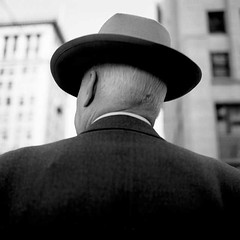 not all) of them. His collection of Maier’s work had grown to over 100,000 negatives, 2000 rolls of film, and 3000 prints, as well as home movies, audio tape interviews, and her original cameras. Maloof’s holdings represent approximately 90 percent of Maier’s work.
not all) of them. His collection of Maier’s work had grown to over 100,000 negatives, 2000 rolls of film, and 3000 prints, as well as home movies, audio tape interviews, and her original cameras. Maloof’s holdings represent approximately 90 percent of Maier’s work.
But Maloof still knew very little about Maier. Who was this woman? Where did she come from? Why hadn’t anyone heard of her remarkable work?
Then in 2009, he saw a small obituary in a Chicago newspaper. It was for Vivian Maier. She had died in a nursing home at age 83. By the time Maloof understood the value of what he had collected, he had lost the chance to speak with her.
Among the materials he had bought at auction, Maloof found a few names and addresses, and he was able to locate these people. They were children from the families for whom Maier had worked. One contact at a time, Maloof tracked down all of the families Maier had worked for, which included the family of TV host Phil Donohue.
They told him what they knew of Maier. Most described her as a quiet, private, but very opinionated person who did not discuss her photography with them. They said she was a socialist, a feminist, a movie critic, and a tell-it-like-it-is type of person. She learned English by going to theaters, and frequently wore men’s clothing and a large hat. She was also decidedly unmaterialistic. Through more digging, Maloof was able to piece together a few details of her early life as well. He was not able to find anyone who was familiar with her photography.
In the two years that followed her death, interest in Vivian Maier’s work exploded, and she is now a genuine sensation in the photography world. Maloof has worked to organize, protect, and publicize his collection of her work. He and his assistants are scanning her negatives, but it is a massive task, and many of Maier’s photographs still have not been seen by anyone.
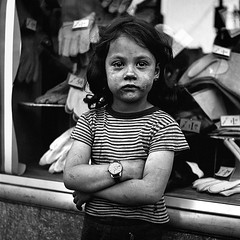 Maloof has put together several exhibits of Maier’s photography that have shown in New York, Los Angeles, London, Norway, Amsterdam, Germany, Denmark, and elsewhere. Articles about her work have appeared in the Wall Street Journal, New York Times, Time, The Smithsonian, Vanity Fair, and other many other publications. Prints of her photos sell for thousands, and a documentary film about Maier’s life is currently being prepared for release in 2012.
Maloof has put together several exhibits of Maier’s photography that have shown in New York, Los Angeles, London, Norway, Amsterdam, Germany, Denmark, and elsewhere. Articles about her work have appeared in the Wall Street Journal, New York Times, Time, The Smithsonian, Vanity Fair, and other many other publications. Prints of her photos sell for thousands, and a documentary film about Maier’s life is currently being prepared for release in 2012.
But in 2010, Chicago carpenter and artist Jeffrey Goldstein acquired another collection of Maier’s work from one of the original auction buyers—the one who refused to sell to Maloof. Goldstein’s Vivian Maier collection includes 15,000 negatives, 1,000 prints, 30 homemade movies, and numerous slides.
A book of Maier’s photography, Vivian Maier: Street Photographer (Powerhouse Books, 2011), also came out recently. It contains two short essays, one by Maloof, but most importantly, over 100 pages of Maier’s beautiful black and white photos. Each one is rich in details and tells a story of American urban life in the mid 20th century.
And the attention devoted to Maier is not likely to end soon, especially since so little of her work has been made available to the public. Expect it to continue surfacing from Maloof, Goldstein, and other sources for years to come. Vivian Maier died in poverty and obscurity. She didn’t get a chance to enjoy the fame and wealth her incredible photography has recently garnered, but she probably would have preferred it that way.
—————————————
Forty Photos by Vivian Maier from the Goldstein collection are on display at the Steven Kasher Gallery, 521 West 23rd Street, New York, until Feb. 25.
